Pilgrimage Tourism
Yatra (Holy trek)
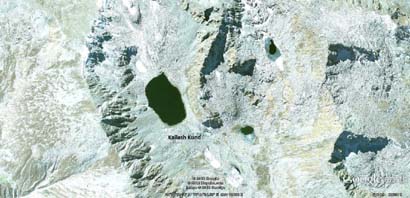
This Yatra follows Mani Mahesh Yatra and starts with Chari from Gatha in Baderwah and then goes to Vasu ki Nag, Ramtund where it stays for the night and then to Kailash. The Yatra takes place in August and ends on the Kailash Kund. It takes 2 hours to cover the periphery of the Kund. Legend has that Ramtund is a mythological places. Legend has that 7 headed snake is seen in Kund. Another Chari reaches The Kailash Kund from Billawer on the same day when the Baderwah Chari reached the Kund. People from Jammu, Kathua, Udhampur come to join Yatra. After one month the same Chari goes to Asha Pathi and reaches there on the day of Amawas. On this occasion there is Dako folk dance for full nights and people from other communities also participate in these functions...
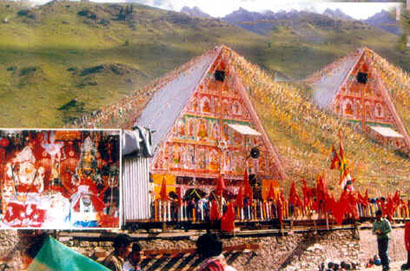
The route of the Yatra is Baderwah-Pul Doda-Thatri-Machail. The Yatra started as a family tradition by Thakurs in 1980s has become a major Yatra in the District. The Yatra culminates in Chandi Mata ki Mandir in Machail.
On 1st July the Yatra with around 2000-3000 people come to Baderwah and for 1 month and 18 days Trishul stays in Baderwah. Then Machail Yatra starts towards Chandi Mata Mandir. Buses come from Jammu on 16 August (around 16 buses) about 40,000 people participate in the Yatra. People in the region attracted to Chandi Mata. People from all communities participate and Trishuls by Jains. Temple facility created by the Yatra organizers has halls for all communities and even for different sects in Hindu Community.
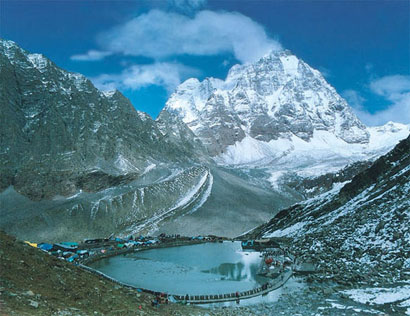
This yatra starts from Baderwah with Chari and goes to Mani Mahesh. The Yatra goes in the month of August. In 2006 the Yatra will start on August 7.
This Yatra precedes Kailash Yatra. Around 10000 people participate in the Yatra. Mani Mahesh Yatra comes back after 7 days. The yatra starts with fanfare including the play of trumpets, Baja...
Holy Fairs
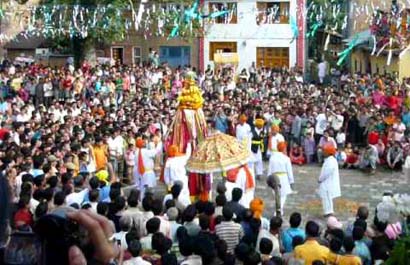
Initiation of Mela Patt dates back to the sixteenth century when Akbar the great, was much impressed by the miraculous spritiual power of Raja Nagpal, the ruler of Bhaderwah. Read More...
Holy Places
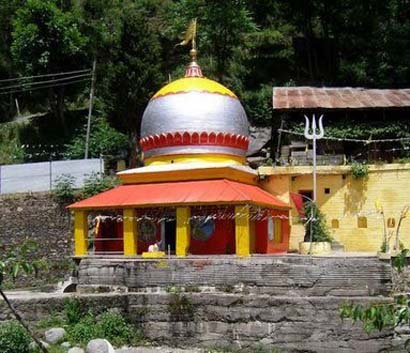
It has a cave and it is said that during Agyatvas Pandavs spent few days here in the land of snakes. A big foot on the rocks of this temple is attributed to Bhim. The legend also goes that there was a tunnel connecting Baderwah to Srinagar. Fishing in 2 kms stretch is prohibited and on the upper and downstream the stream has trout fish. Shantana Nag temple: This temple at Sarthangal is considered to be Surya and Kali Mata temple.
Is a majestic peak having a height of 11,000 feet. One one side is situated the sleepy valley of Jai and humming valley of Chinta while on other side is the hitherto unexplored region of Chiralla. Reushira peak is beset with ancient temple of Goddess Durga. Thousands of devotees visit the temple to offer prayers, especially during Navratras.
On the Western side of Satangal Power House an acient temple of Shantan Nag is situated on a hillock. Being surrounded by thick devdar trees, the place offers fascinating scene. Though the small temple is bereft of any idols there are some ancient shivlingams present in the small ground around the temple. Recently, an ancient idol of Lord Surya has been found in the temple yard that speaks volumes about thepast glory of the temple.
Shantan Nag who is considered as one of many brothers of Vasuki Nag is supposed to be a powerful deity.
If he saves his worshippers from evil, he also punishes those showing disgrace to him. Sant Ram was one of the poojaris of Shantan Nag. He used to perform pooja of the Naag deity regularly. But when he became old his sons took the pooja casually every one of the family perished. Today their house and land have been occupied by some one else.
There is yet another example that shows how powerful Shantan Nag has been. In the vicinity of Shantan Dehra, there lives a Muslim family which flourished and prospered in a phonetic manner as long as it paid obesince to the Nag in their own way. But the hundred year old unity of this family of 80/90 souls fell like a sand wall when its younger generation stopped respecting the holy deity. Today the family stands shattered and fragm-ented in dozens of small families quarreling and fighting with each other.
People though visit Dehra as and when they want his blessings, yet the main function is held on Herai jater that falls in the month of July/August every year when the priest amidst chanting of religious slogans destroys the heap of burning charcoal in wajad called grehni. In the same condition he makes a forecast about the coming events that generally turns true.
Perched on a hillock called Rehoshra on the Eastern side of Chinta valley is the ancient Seetla Mata temple. Till recently, an old time dharamshala also existed here, but when militancy broke militants loaded with communal frenzy burnt the ancient structures without destroying the faith of people in Mata though. A grand temple is on anvil, which will soon come up with money collected from the followers of the Mata. Poojaris who belong to nearby village Sunarthao have been performing worship of the Mata since time immemorial though during harsh winters the pooja has to be abandoned when the hill is covered by heavy snow. There is an ancient idol of Goddess Seetla in the temple. People both local as well belonging to adjoining Chamba and Kathua throng in large numbers to pay obeisance to the Mata throughout the year, but the main function is held on 8th Navratra falling in September/October every year when hundreds of lambs are sacrificed and their mutton distributed, cooked and eaten as prashad.
On the nearby Jantroon Dhar about a couple of miles away from Rihoshra is a pond of crystal clear water. It is situated at the highest portion of the hill where chances of water coming from around are bleak. Still the pond remains full of water throughout the year. Surprisingly, there is a thick sheet of grass spread over the surface of the pond and holes have been made in the grass sheet through which devotees hang themselves to have a dip of holy water. It is believed that fairies bathe in the pond and to hide themselves from human eyes they have woven the grass sheet over the surface of the pond. People in large numbers from the surrounding villages reach for taking a dip in the holy water on full moon day of Sawan( July-August) every year.
The ancient temple of Subar Nag on the sprawling Subar pasture opens for Darshans on first of Baisakh(April 13) every year. The location of the temple is such that Bhaderwah town though miles away can be seen from here. The temple houses an ancient idol of Subar Nag. Like the idol the temple of Subar Nag was also an ancient one which fell victim to the frenzy of militants and was burnt during mid nineties when militancy was at its peak. Now an RCC structure at the place of the ancient temple has come up here.
Thousands of devotees from surroun-ding areas including Chinta, Bhalra, Barasua, Chirala and Bhlara throng thr holy place and celiberate Baisakhi every year. Another festival is held in the temple on the annual Jater of Chinta that falls in Bhadon( July). This day before dawn, people in large numbers reach Subar Temple carrying wooden Mashals in their hands. These Mashals are put one on another in the form of a camp fire that soon turns into a big heap of glowing coal, which is destroyed by the priests bare foot amidst chanting of religious slogans. During the process the pujaris make fore cast, which generally comes true. It is also believed that the newly wed young man whose Mashal reaches the compound of the temple first gets a male baby from his wife due to the blessings of the deity Nag.
Thubu Nag is yet another deity that is famous for blessing his devotees with a male baby. Its temple is situated on a hill a little above the Bhaderwah- Jai Road that separates Bhaderwah from Chinta valley. Both the vallies can be seen from here. In the wee hours of the morning following Malchey second annual jater of Chinta valley falling in the autumn every year a large procession starting from Karai reaches Thubu Temple and performs pooja there.
On the right side of Bhaderwh-Jai pedestrian is situated the temple of Nagni Mata, which is considered as sister of Thubu Nag. People in large numbers in the form of procession converge at Nagni Mata Temple every year on first Baisakh for paying obeisance to their deity Goddess. On this occasion langer are organized and meat of the lambs that are sacrificed in honour of the Mata is served as prasad.
This is yet another ancient temple in Bhaderwah locality. This temple which is situated on a hill top is the only temple where ancient musical instruments made of Copper are played upon to please the deity even today. The main festival is held on Janamashtmi. The deity housed in the ancient temple is known for great spiritual powers. Some years ago some one ventured to capture a portion of the temple land. When all efforts, legal or otherwise failed, people of the area prayed before the deity to punish the trespassers. It is said that since then no healthy child has born in the defaulter family.